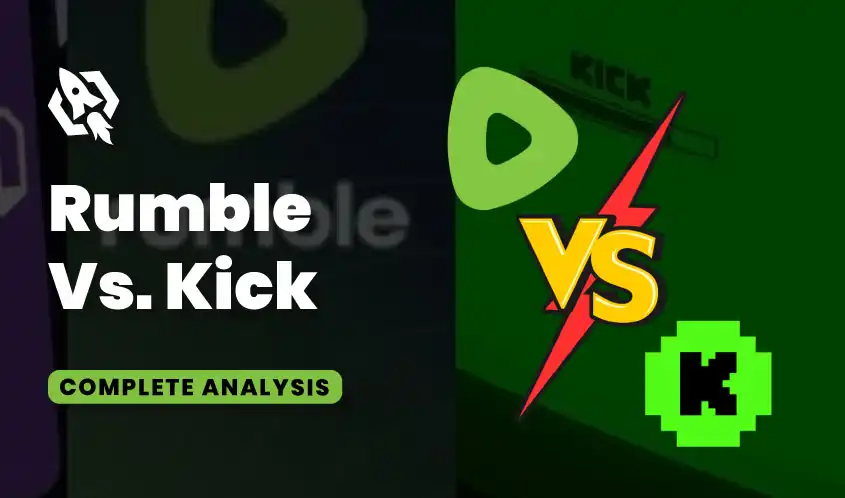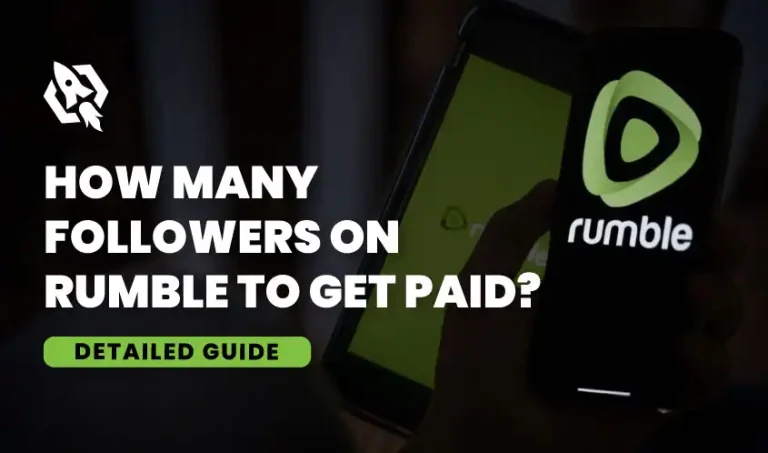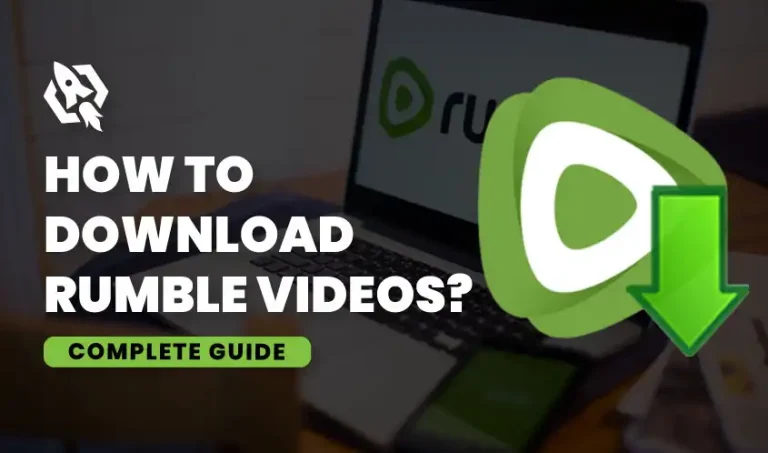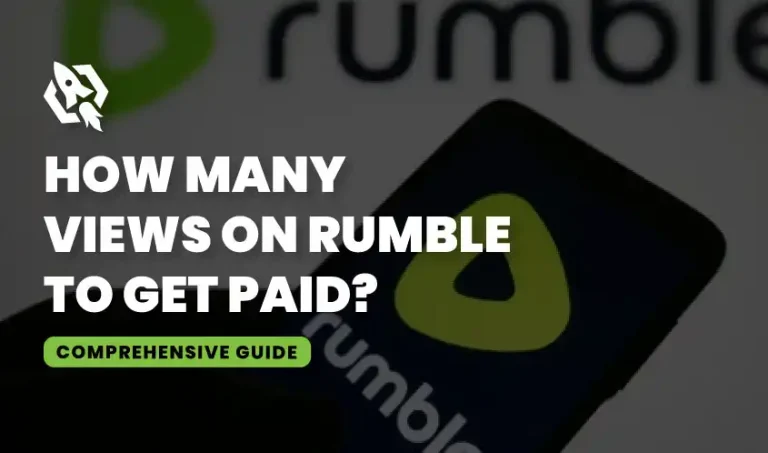Anybody with a camera and an idea can now share their voice with the world thanks to content creation, which has transcended traditional media in the digital age. With unique benefits, platforms such as Rumble and Kick have become indispensable instruments for content creators.
While both offer similar features, such as video monetization and community engagement, they also have distinct differences that make them stand out from each other. Rumble is known for its robust video editing tools, wide content distribution network, and strong focus on free speech. On the other hand, Kick excels in live streaming capabilities and real-time interaction with the community. Ultimately, the choice between Rumble and Kick depends on individual preferences and goals.
The purpose of this thorough comparison is to help you make the best decision possible by illuminating the salient characteristics, advantages, and possible disadvantages of both platforms.
History and Overview of Rumble and Kick
Rumble:
Founded in 2013 by Chris Pavlovski, Rumble is a Canadian online video platform that has gained traction for its commitment to free speech and minimal content censorship. It was created as an alternative to mainstream platforms like YouTube, focusing on providing creators with better monetization opportunities and a fairer share of revenue.
Rumble boasts a diverse user base, including content creators from various niches, such as politics, news, entertainment, and lifestyle. As of 2022, Rumble reported over 30 million active users, a testament to its growing popularity among creators seeking an alternative to more restrictive platforms.
Rumble’s user engagement metrics are impressive, with high average watch times and a strong presence in North America and Europe. Its appeal lies in its commitment to creator-friendly policies and less stringent content moderation.
Kick:
Kick, a newer entrant in the social media landscape, was launched in 2020. Its creators envisioned a platform that combines the best elements of live streaming and social interaction. Kick offers a unique blend of real-time engagement and content-sharing capabilities, aiming to foster a highly interactive community.
Kick, while newer, has rapidly gained a dedicated following, particularly among younger audiences and live streamers. With a focus on real-time interaction, Kick appeals to gamers, influencers, and anyone looking to build a tight-knit community. As of 2022, Kick has amassed over 10 million active users.
Kick’s popularity is bolstered by its unique approach to merging live streaming with community engagement. It has seen exponential growth in regions like Asia and South America, with users spending significant time on live broadcasts and interactive sessions.
Difference in the Content Creation Tools of Both Platforms
The following is the difference between the tools used by Rumble and Kick for the creation of the content:
Editing Features of Rumble:
Rumble offers a robust suite of video editing tools built into its platform. Creators can trim, merge, and add effects to their videos directly from the upload interface. Additionally, Rumble supports high-definition uploads, ensuring your content maintains quality.
Editing Features of Kick:
Kick excels in live streaming capabilities, providing intuitive tools for real-time video editing. Streamers can manage overlays, chat interactions, and transitions seamlessly. For pre-recorded content, Kick integrates with popular third-party editing software, offering flexibility for creators.
Monetization Options Provided by Rumble and Kick
One of Rumble’s standout features is its generous revenue-sharing model. Creators earn through advertisements, subscriptions, and direct donations from fans. Rumble also offers a unique licensing option, allowing creators to monetize their content through syndication deals with media companies.
On the other hand, Kick provides multiple monetization streams, including ad revenue, viewer subscriptions, and virtual gifts. Its partnership program offers additional perks, such as higher revenue splits and exclusive promotional opportunities.
Content Distribution & Reach of Rumble Vs Kick
Rumble’s content distribution network is extensive, with partnerships that allow creators to reach wider audiences through syndication. Rumble videos often get featured on high-traffic websites, enhancing visibility and engagement.
While Kick focuses on creating a highly interactive ecosystem, Live streams and videos are easily shareable across social media platforms, driving organic growth. Kick’s algorithm prioritizes new and trending content, giving creators a fair chance at gaining visibility.
Rumble vs Kick User Experience
1. Interface & Usability of Rumble and Kick
Rumble’s interface is user-friendly, with a straightforward layout that makes navigation simple. The platform offers comprehensive analytics, helping creators track performance and engagement metrics. However, some users find the design somewhat dated compared to newer platforms.
Kick shines with its modern, sleek interface designed for ease of use. The platform’s interactive features, such as live chat and real-time notifications, enhance user experience. Kick also offers customizable profiles, allowing creators to personalize their presence.
2. Community Engagement of Rumble and Kick
Rumble fosters a supportive creator community with features like comment sections, user forums, and collaboration opportunities. The platform’s commitment to free speech attracts a diverse audience, encouraging open dialogue.
Community engagement is at the heart of Kick’s design. Real-time interactions during live streams create a dynamic environment where creators and viewers connect on a personal level. Kick’s community challenges and events further boost engagement.
3. Customer Support of Rumble and Kick
Rumble offers responsive customer support through email and a dedicated help center. Premium users receive priority assistance, ensuring quick resolution of issues. For self-help, the portal also has a thorough FAQ section.
Kick offers thorough customer service across a variety of platforms, such as social media, email, and live chat. The responsive support staff is renowned for its efficient problem-solving and rapid response times. Kick also maintains an active user forum for peer assistance.
Rumble Vs Kick SEO & Discoverability
Search Engine Optimization of Rumble and Kick:
Rumble places a strong emphasis on SEO, with features designed to enhance discoverability. Creators can optimize video titles, descriptions, and tags to improve search rankings. Rumble’s partnership with major search engines ensures that content is indexed and easily found.
Kick’s SEO capabilities are equally impressive, with tools to optimize keywords, metadata, and video descriptions. The platform’s integration with social media amplifies reach, driving traffic from external sources. Kick’s algorithm promotes trending content, boosting visibility.
Algorithm Insights of Rumble and Kick:
Rumble’s algorithm is designed to reward high-quality content, with a focus on engagement metrics like watch time and user interaction. Consistent posting and audience retention are key factors in gaining traction on the platform.
Kick’s algorithm prioritizes real-time engagement, making live interaction a critical component of success. The platform’s recommendation engine highlights new and trending streams, giving creators ample opportunities for exposure.
Privacy & Security offered by Rumble and Kick
Data Protection Security by Rumble and Kick:
Rumble is committed to data protection, adhering to stringent privacy policies and industry standards. The platform employs advanced encryption and security measures to safeguard user information.
Kick, on the other hand, takes user privacy seriously, implementing robust security protocols and data encryption. The platform’s privacy policy is transparent, detailing how user data is collected, stored, and used.
User Privacy Policies of Rumble and Kick:
Rumble’s privacy policy is comprehensive, outlining user rights and data handling practices. The platform respects user anonymity and provides options for controlling data-sharing preferences.
Kick’s privacy policy emphasizes user control and transparency. The platform offers granular privacy settings, enabling users to manage their data and interaction preferences effectively.
Cost & Accessibility of Rumble Vs Kick
Subscription Plans of Rumble:
Rumble offers a free tier with basic features, making it accessible to all creators. The premium subscription unlocks advanced tools, enhanced monetization options, and priority customer support. Pricing is competitive, catering to both individual creators and businesses.
Subscription Plans of Kick:
Kick operates on a freemium model, with a range of subscription plans tailored to different needs. The basic plan provides essential features, while premium tiers offer enhanced tools, exclusive content, and higher revenue shares. The flexible pricing structure makes Kick accessible to a wide audience.
Device Compatibility of Rumble Vs Kick
Rumble is compatible with various devices, including desktop, mobile, and smart TVs. The platform’s mobile app offers a seamless experience, allowing creators to manage their content on the go.
Kick’s cross-platform compatibility ensures a consistent experience across devices. The mobile app is optimized for live streaming, providing creators with the tools they need to engage their audience from anywhere.
Advantages and Disadvantages of Using Rumble and Kick
Before finalizing the choice between Rumble and Kick, take a look at both the benefits and drawbacks of both platforms:
Benefits of Rumble:
- Freedom of Speech
Rumble is often celebrated for its commitment to free speech. In today’s climate of increasing content moderation and censorship, Rumble stands out by allowing creators to express their views without the fear of being de-platformed.
- Monetization Opportunities
Rumble offers multiple revenue streams for content creators. Not only can you earn through ad revenue, but Rumble also provides options for licensing your videos to other media outlets. This multi-faceted approach can result in higher earnings compared to traditional platforms.
- Easy-to-Use Interface
One of Rumble’s strengths is its user-friendly interface. Whether you’re a newbie or a seasoned content creator, navigating through the platform is straightforward, allowing you to focus more on creating content rather than learning the ropes.
- Growing Popularity
Rumble has experienced significant growth in user numbers, partially driven by creators seeking alternatives to YouTube and other mainstream platforms. This growing user base can translate into a larger audience for your content.
Drawbacks of Rumble:
- Smaller Audience
Despite its growing popularity, Rumble still lags behind giants like YouTube in terms of user base. This can limit your reach, especially if you’re looking to tap into a global audience.
- Limited Features
While Rumble offers essential features for video sharing, it lacks some of the advanced tools available on other platforms. For example, its analytics and community interaction features are not as robust as those found on YouTube.
- Niche Content
Rumble tends to attract a specific type of content and audience, often leaning toward political and opinion-based videos. If your content doesn’t align with these niches, you may find it challenging to build a substantial following.
Benefits of Kick platform:
- Innovative Features
Kick aims to differentiate itself with a range of innovative features designed to enhance user experience. From advanced analytics to interactive live-streaming capabilities, Kick is continually updating its platform to stay ahead of the curve.
- Community Engagement
Kick places a strong emphasis on community building. Features like audience polls, live chat, and interactive Q&A sessions make it easier for creators to engage with their viewers, fostering a sense of community.
- Flexible Monetization
Kick offers flexible monetization options, including ad revenue, subscriptions, and viewer donations. This flexibility allows creators to choose the monetization strategy that best aligns with their content and audience.
- Creative Freedom
While Kick also enforces content guidelines, it offers more creative freedom compared to some mainstream platforms. This balance between moderation and freedom can be appealing to creators looking for a middle ground.
Drawbacks of Using Kick:
- Smaller User Base
As a relatively new platform, Kick’s user base is not as extensive as established platforms. This can make it harder for creators to gain visibility and attract a large audience quickly.
- Unproven Monetization Model
While Kick offers multiple monetization options, its revenue-sharing models are still relatively untested. This uncertainty can be a drawback for creators looking for reliable income streams.
- Platform Stability
New platforms often face technical glitches and stability issues as they scale. While Kick is continually working to improve its infrastructure, these growing pains can affect user experience.
- Content Moderation
While Kick does offer more creative freedom, its content moderation policies are still evolving. This can lead to inconsistencies in how content is reviewed and moderated, potentially impacting creators.
Choose the Platform According to Your Needs
Both Rumble and Kick offer unique advantages for content creators, making the choice between them dependent on your specific needs and goals.
- Choose Rumble if you prioritize robust video editing tools, a generous revenue-sharing model, and wide content distribution. Rumble is ideal for creators who focus on pre-recorded content and value minimal content censorship.
- Choose Kick if you are a live streamer looking for a modern, interactive platform with high community engagement. Kick’s intuitive interface and real-time interaction features make it perfect for building a dedicated audience and fostering connections.
FAQs
Rumble focuses on providing robust video editing tools, a generous revenue-sharing model, and wide content distribution, making it ideal for pre-recorded content. Kick, on the other hand, excels in live streaming and real-time community engagement, catering to creators who prioritize interactive content.
Yes, both Rumble and Kick offer multiple monetization options. Rumble provides ad revenue, subscriptions, and licensing deals, while Kick offers ad revenue, viewer subscriptions, and virtual gifts.
Kick is better suited for live streaming, offering intuitive tools for real-time video editing, high community engagement, and features like live chat and customizable profiles.
Yes, both Rumble and Kick are compatible with mobile devices. Each platform offers a mobile app that allows creators to manage their content and engage with their audience on the go.
Rumble has a larger user base and is more established, with over 30 million active users. Kick, while newer, has rapidly gained popularity, particularly among younger audiences and live streamers, with over 10 million active users.
Conclusion
In summary, every platform offers advantages and disadvantages, and the optimal selection relies on your preferred method of creating content and how your audience interacts with it. Both Rumble and Kick are effective platforms for content producers to exhibit their work and interact with viewers.
While Rumble excels in robust video editing tools and wide content distribution, Kick stands out for its live streaming capabilities and community interaction features. Ultimately, the best platform for you depends on your specific needs and goals as a creator.
Whether you prioritize pre-recorded content or real-time engagement, both Rumble and Kick offer unique advantages for creators to thrive in the digital landscape.




